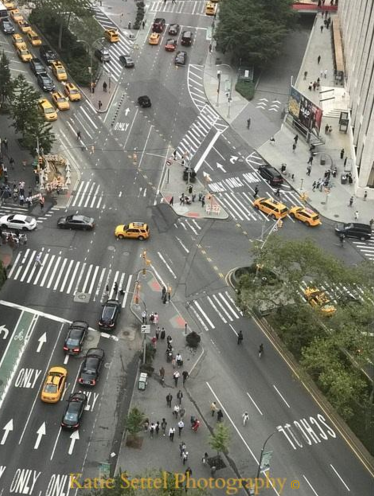Full Disclosure
I’m a city gal who has not spent a whole lot of time in forests, but the forest/trees analogy is a great way to think about structuring presentations. So just for fun, let’s reimagine the “forest for the trees” in a modern cityscape, as in this photo of a downtown intersection.
What Should We Call This?
Can’t see my route for the cars and taxis?
Can’t see my correct turn for the arrows in the street?
Can’t choose a lane for the multiplicity of choices?
Can’t the heck figure out my next move for the confusion?
Where am I going?
A Picture is Worth a Thousand Words
And this one, taken by my friend and colleague, photographer Katie Settel, captures the difference between being in our stuff and being above it, looking down.
Perspective is The Key
This is the greatest gift you can give your audiences. But first you have to gain it for yourself. And it can be a struggle.
As a Keynote Speaker myself, and a Coach to business people who present, I fully understand the often-paralyzing difficulty of wading into our material/data/ideas/stories and figuring out the structure. Consider it a two-step process: wade in and immerse yourself, and then step back out to get perspective.
Three Ideas to Jumpstart Your Process
1) Big Picture It
Don’t be so concerned with the specifics that you miss the larger situation. Always start with the Big Picture. Best-selling business author Steven Covey calls this “Begin with the end in mind.” (The 7 Habits of Highly Effective People). Give your audience an opening context with which they will listen to your words.
2) Bottom Line It
Always net it out. What’s the Bottom Line? When all is said and done, what’s the take-away for your listeners? Ideally this is simple and memorable. Think of it as what you want people to be saying as they leave the room or gather at the coffee machine later.
3) Synthesize It
Your job as a presenter is to put a stake in the sand and take a stand, for something. Even something small. Have a Point of View by synthesizing disparate information into something coherent and whole. Discern and suggest an over-all pattern. This is why you are presenting, and not someone else.
Narrow-View and Wide-Angle Lens
It’s the combination of in-close detail and up-high perspective that gives your presentation rhythm and flow. I like to think of it as a camera lens that zooms in and out. Here’s a bonus: Not only does this structure work for your presentation as a whole, but you can also use it for individual slides. Try it!
Final Thought
Let’s remember that without those lane markers in the street, we’d all be in trouble. There’s a place for everything.
See you in the fast lane.
